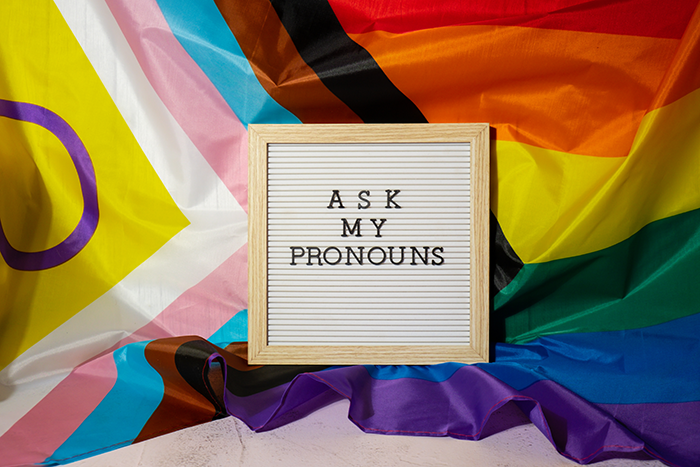LGBTQIA+ college students face many challenges at home and on campus. Stigmas in society regarding their gender and sexual orientation can impact their interactions with others as well as their self-esteem and mental health.
Because the college environment strongly influences students, school administrators and staff have an excellent opportunity to create a positive environment for LGBTQIA+ students.
As a leading provider of student health insurance plans, the team at Wellfleet Student is committed to student wellness. That’s why we work so hard to provide inclusive healthcare that advocates for diversity, equity, and inclusion (DEI).
In this blog, we’ll discuss how schools can positively affect the college experience for LGBTQIA+ students.
How to support LGBTQIA+ students
Creating a community of caring on campus starts at the top, so it’s your responsibility to help students feel safe, comfortable, and healthy.
Here are eight ways to foster a supportive college environment for LGBTQIA+ students:
1. Understand their experience
LGBTQIA+ students face a unique set of challenges on campus. Understanding their perspective can help improve the college experience for these students.
Students who identify in the LGBTQIA+ community may deal with discrimination, family disapproval, harassment, rejection, and more. According to the Human Rights Foundation, this puts LGBTQIA+ youth at increased risk for negative health outcomes.1 For example, these individuals experience an increased risk of pregnancy, HIV, and other sexually transmitted diseases (STDs).2
In addition to health challenges, LGBTQIA+ youths also experience social and mental health challenges. According to the 2023 U.S. National Survey on the Mental Health of LGBTQ Young People report, while our culture has made encouraging progress in acceptance of the LGBTQIA+ youth community, significant challenges remain. These can include gender and racial discrimination, suicide ideation, food insecurity, harassment, and reduced access to healthcare.3
2. Post safe space signs

Posting safe space signs throughout your campus and learning spaces can put LGBTQIA+ students at ease, knowing they are in a space where they will be respected. When these signs are not posted, students may question whether they will feel welcomed and safe in the area.
Making the effort to reassure them that they can trust those in charge of the space can put their minds at ease and help them feel more comfortable on campus. Remember that for these signs to hold meaning, the campus needs to define expectations from the student community and educate the campus on what the signs represent.
3. Improve access to healthcare
Because LGBTQIA+ students can experience bias from healthcare providers,4 these students may be apprehensive about seeking care. That’s why providing the means for them to seek the care they need in a trusted environment is essential.
Creating collaboration between the student health insurance carrier, local providers, and student health center staff can help ensure students can easily access LGBTQIA+ specialists who will provide high-quality care.

Having resources that allow students to seek care on their own terms is also important. Provide access to telehealth programs like doctor visits, at-home STI testing, and 24/7 behavioral healthcare services like CareConnect. Offering your students access to programs like these puts them in control and makes it easier for them to seek care.
4. Empower staff to provide support
Your professors, faculty, and staff are your feet on the ground, interacting every day with students. Having a faculty that’s supportive and welcoming to the LGBTQIA+ community is essential for developing a strong community on campus. It only takes one negative experience with a professor for a student to feel unwelcome in class.
Ensure your human resources department is effectively vetting potential faculty regarding their commitment to DEI. Having the right people on board creates a more caring and supportive community. Additionally, spend the time and resources to train and educate your current staff on how to listen effectively, support students in need, and interact inclusively.

5. Explore and provide LGBTQIA+ resources
Education is the key to understanding and acceptance. An educated staff and student body will make for a more welcoming community for LGBTQIA+ students.
Include quality resources in faculty training sessions and focus on helping faculty expand their knowledge of the LGBTQIA+ community’s needs.
Providing quality resources throughout campus can be beneficial for many reasons. It can:
- Help LGBTQIA+ students feel safe and accepted
- Offer direction and support to students who are struggling
- Increase awareness and education throughout the whole student body
Some excellent LGBTQIA+ resources to reference and share on your campus include:
- Gay-Straight Alliances (GSA): This group offers support and activities for LGTBQIA+ youth.
- The Trevor Project: The Trevor Project provides a 24/7 hotline for LGTBQIA+ students and has an online community and educational programs.
- International Lesbian, Gay, Bisexual, Transgender People, and Queer Youth and Student Organization (IGLYO): IGLYO hosts conferences that can provide places with resources and educational resources.
- It Gets Better Project (IGB): This organization offers numerous resources and educational videos.
- Attic Youth Center: This program offers mental health resources and social activities.
6. Respect pronouns and names
One essential aspect of showing acceptance and respect toward those in the LGBTQIA+ community is to use their preferred* names and pronouns. This also includes updating the school’s data systems to ensure they store students’ preferred names and pronouns.
Many individuals may have undergone a transition or are in the process of transitioning to a gender that more accurately fits them. As a part of the transition process, many students decide to change their pronouns and/or names to reflect their inner selves.
Respecting this change is a way to show that you see and respect the individual for who they are. When students are referred to by their deadname, they may feel hurt and unsupported.

Throughout your campus, set the standard for acceptance. That means educating your faculty and students on the importance of using preferred names and pronouns. Have a zero-tolerance policy for discriminating or disparaging remarks toward those in the LGBTQIA+ community.
7. Allocate resources to building LGBTQIA+ community and safe spaces
If you want your campus to be a welcoming space for all students, you must invest in making that happen. Providing financial support for LGBTQIA+ groups, events, and initiatives is a great way to take positive action.
Additionally, talk with your students and determine whether your campus needs physical changes to better accommodate LGBTQIA+ students. For example, your campus may need more safe spaces, better housing options, or more accommodating bathrooms for LGBTQIA+ students.
Once you see a gap, consider investing in making needed campus updates so students feel welcome.
8. Improve the culture
Lastly, we encourage you to take an honest look at the culture on your campus. Is it where it needs to be? If not, it’s time to act.
Get honest feedback from students and faculty about the current state of the culture. Are faculty supportive of LGBTQIA+ students? Does your campus attract LGBTQIA+ students, or do they feel unwelcome? Are you providing safe spaces where all students feel accepted?
When asking these questions, you may uncover some difficult answers. Create an action plan for addressing weaknesses and gaps. Get your faculty on board and work closely with students to ensure you’re providing the services they need.
Colleges are uniquely qualified to shape and educate the next generation of leaders by promoting inclusivity across disciplines. Your campus has the power to help promote equality and reduce discrimination. Focus on improving the campus culture, and a more welcoming community will arise.
Learn more about Wellfleet Student
To learn more about creating an inclusive student health insurance plan that puts you and your students first, contact our Sales team.
*We are using the term preferred pronoun for reader clarity, but we recognize that one’s preferred name is their name.
Resources
1 Human Rights Foundation (2023).2023 LGBTQ+ Youth Report. https://reports.hrc.org/2023-lgbtq-youth-report
2 Rasberry CN, Lowry R, Johns M, et al. Sexual Risk Behavior Differences Among Sexual Minority High School Students — United States, 2015 and 2017. CDC MMWR Morb Mortal Wkly Rep. https://www.cdc.gov/mmwr/volumes/67/wr/mm6736a3.htm?s_cid=mm6736a3_e.
3 The Trevor Project. (2023). 2023 U.S. National Survey on the Mental Health of LGBTQ Young People. https://www.thetrevorproject.org/survey-2023/.
4 Casanova-Perez, R, et al. (2022, February 21). Broken down by bias: Healthcare biases experienced by BIPOC and LGBTQ+ patients. AMIA Annu Symp Proc. https://www.ncbi.nlm.nih.gov/pmc/articles/PMC8861755/.
CSP-SHIP-NOVEMBER-2023-1


